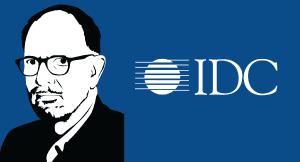Partner:
 Thank you to IDC for underwriting CXOTALK.
Thank you to IDC for underwriting CXOTALK.
The pressure to deliver differentiation as a means of competitive advantage is a critical driver for the changing nature of experiences across customers, partners, and suppliers. The IDC EXPERIENCES Survey 2015 highlights the notion of "experience" and how initiatives are maturing and coming together around five core components: customer experience, workforce, commerce, business networks, and innovation (products and services). The ability to link those experience components together in order to deliver a holistic view of digital and social transformation is at the epicenter of the differentiation. The survey shows that providing a consistent experience across multiple engagement channels is a key focus for companies as well as the means to ensuring that employees, business partners, and suppliers have a unified view of interactions.
With many organizations characterized as a post-industrial enterprise, business modernization can provide a stronger way to discuss the ensuing transformation. Technology is at the core of the linkages that need to be made, but it is far from simply implementing some new software/hardware, automating processes, and learning a new workflow. The changes that need to take place to deliver this differentiation are much more fundamental and alter the way work gets done, the type of work that is done, and ultimately way people interact.
Some key insights from the IDC 2015 EXPERIENCES Survey include:
- Customer experience has been the most visible and important "experience" initiative to date. According to the survey, 81% of respondents use customer satisfaction surveys to measure the customer experience with their company. Yet many organizations are wrestling with the interactions they deliver versus the technology that has been put in place to "manage" these interactions. And when it comes to employees, 69.4% of companies do not measure their experiences at all. These "experiences" can incorporate prescribed business processes, corporate strategy, business impacts, and perceived challenges.
- Online communities are considered an important interaction channel across all experience types. The community, or peer-to-peer support community as it is commonly called, provides an alternate support channel that is self-serve and leverages interaction across the customer base. There are businesses that have the need for multiple communities that reach different constituent types, customer, employee, partner, and supplier. These types of businesses include companies that have multiple brands or different business models that reach both business to business (B2B) and business to consumer (B2C).
- Training and hiring are critical to delivering excellent experiences across customer, employee, partner, and supplier. However, it is a continuous challenge for many organizations. As the nature of work changes and business processes become more ad hoc, training employees to manage exceptions, while at the same time delivering seamless interactions across multiple engagement channels, will become increasingly complex but essential.
- The future of business is connected, and the way we work, collaborate, and simply connect with our customers, employees, partners, and suppliers is rapidly changing. A core component of this is the combination of a new set of connected users who have an increasing requirement to access information for decision making and the ubiquity of cloud-based applications to connect to these increasingly disparate information sources. Beyond this is the ability to link customer and partner experience, workforce, commerce, and innovation together in order to deliver a holistic view of the opportunities afforded through business modernization.
Software providers can no longer be prescriptive about how users will interact, transact and get their work done. More and more employees, customers, partners and suppliers are becoming empowered to use applications and systems beyond the ways they were initially prescribed. This means that those individuals will have more control over how they interact to deliver a business outcome or output. This is a fundamental shift in the way we have previously thought about delivering systems that connect people to people to information. In a successful shopping experience, a store doesn't instruct you how to interact with it, it finds you where you want to transact, whether that be online, on a mobile device, or in a store, and makes the transaction happen there. Similarly, organizations need to start meeting users where they want to work, interact, and transact. In addition:
- The business network is forming a new framework for productivity and value creation across a broad set of business functions. Customer communities and their effect on customer experience is one part of this. Organizations are wanting to drive more awareness of their brand as well as have an ongoing conversation with customers. This ongoing conversation is particularly suited to online communities where brands can quickly build a trust relationship with customers, employees, partners, and suppliers. Beyond this, there is an opportunity for online communities to become marketplaces of their own where partners and suppliers are able to start transacting in the community to help solve other customer or partner questions. Other successful communities engage in gamification to incentivize user participation.
- In connected commerce experiences, leveraging the Internet and new connected technologies like mobile, cloud, and the Internet of Things is offering networks that can increase business performance and reduce costs while creating competitive advantage. In particular, marketplaces create a high-performance platform for suppliers and procurement professionals to build collaborative relationships and execute in more efficient and effective ways.
- Gaining a better understanding of the workforce from recruit to retire means understanding not only the outcomes and outputs but the skills and dynamics of employees. As employees get asked to do more in their daily work, roles may be shifting slightly to encompass an expanded set of outcomes and outputs. In addition, processes that are shared with other users in the same or different business functions are often not accounted for as part of an individual's KPIs. More fundamentally though, the way a user may now need to execute tasks as part of existing roles has become much more ad hoc in nature. Understanding how users are interacting on a task level can add insight into how an organization may be able to operate and incentivize users in the future.
- To meet the changing needs of customers, partners, and suppliers, organizations need to become more agile. This does not isolate the conversation to an IT department using agile development methodologies rather than the traditional waterfall methods — this is a key component, but it is not the whole picture. Organizations are realizing that as all business constituents become more empowered, they are forcing those organizations to transact with them wherever they are — in-store, online, mobile, and social.
Additional detail can be found in the IDC study, The Opportunities and Challenges of Delivering Superior Experiences: IDC's EXPERIENCES Survey (IDC #256564). A total of 799 senior executive-level decision makers in the United States were polled on their current and future technology, business plans, and perceptions related to the experiences being delivered to customers, employees, partners, and suppliers.
Presented By: IDC
Jul 17, 2015


